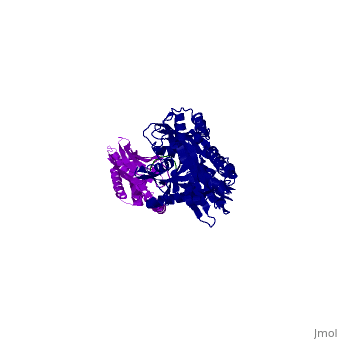Chaperones
From Proteopedia
(Difference between revisions)
| Line 1: | Line 1: | ||
| - | <StructureSection load=' | + | <StructureSection load='Heat shock proteins' size='340' side='right' caption='' scene='59/591341/Heat_shock_proteins/1'>hsp</scene'> |
Chaperones are proteins that are involved in the non-covalent folding and unfolding of other macromolecules. It exists both in prokaryotes and eukaryotes. Some chaperones are constitutively expressed in the system however, there are other chaperones that are expressed only in response to an external stimulus or stress such as heat and therefore they are referred to as ''heat shock proteins''.They are classified based on their structure, size, molecular weight and function in to several classes such as Hsp100, Hsp90, Hsp60 [[Chaperonin]], small heat shock proteins (alpha)-crystallin proteins. They do not undergo denaturation themselves when exposed to stress because of better hydrogen bonding, strong hydrophobic core interactions, enhanced secondary structure and helix dipole stabilization. | Chaperones are proteins that are involved in the non-covalent folding and unfolding of other macromolecules. It exists both in prokaryotes and eukaryotes. Some chaperones are constitutively expressed in the system however, there are other chaperones that are expressed only in response to an external stimulus or stress such as heat and therefore they are referred to as ''heat shock proteins''.They are classified based on their structure, size, molecular weight and function in to several classes such as Hsp100, Hsp90, Hsp60 [[Chaperonin]], small heat shock proteins (alpha)-crystallin proteins. They do not undergo denaturation themselves when exposed to stress because of better hydrogen bonding, strong hydrophobic core interactions, enhanced secondary structure and helix dipole stabilization. | ||
== Function == | == Function == | ||
Revision as of 14:24, 17 June 2014
| |||||||||||
References
- ↑ Ellis J. Proteins as molecular chaperones. Nature. 1987 Jul 30-Aug 5;328(6129):378-9. PMID:3112578 doi:http://dx.doi.org/10.1038/328378a0
- ↑ Deshaies RJ, Koch BD, Werner-Washburne M, Craig EA, Schekman R. A subfamily of stress proteins facilitates translocation of secretory and mitochondrial precursor polypeptides. Nature. 1988 Apr 28;332(6167):800-5. PMID:3282178 doi:http://dx.doi.org/10.1038/332800a0
- ↑ Halperin L, Jung J, Michalak M. The many functions of the endoplasmic reticulum chaperones and folding enzymes. IUBMB Life. 2014 May 19. doi: 10.1002/iub.1272. PMID:24839203 doi:http://dx.doi.org/10.1002/iub.1272
- ↑ Gurard-Levin ZA, Quivy JP, Almouzni G. Histone chaperones: assisting histone traffic and nucleosome dynamics. Annu Rev Biochem. 2014 Jun 2;83:487-517. doi:, 10.1146/annurev-biochem-060713-035536. PMID:24905786 doi:http://dx.doi.org/10.1146/annurev-biochem-060713-035536
- ↑ Matambo TS, Odunuga OO, Boshoff A, Blatch GL. Overproduction, purification, and characterization of the Plasmodium falciparum heat shock protein 70. Protein Expr Purif. 2004 Feb;33(2):214-22. PMID:14711509
- ↑ Misra G, Ramachandran R. Hsp70-1 from Plasmodium falciparum: protein stability, domain analysis and chaperone activity. Biophys Chem. 2009 Jun;142(1-3):55-64. doi: 10.1016/j.bpc.2009.03.006. Epub 2009 , Mar 16. PMID:19339102 doi:http://dx.doi.org/10.1016/j.bpc.2009.03.006
- ↑ Kim YE, Hipp MS, Bracher A, Hayer-Hartl M, Hartl FU. Molecular chaperone functions in protein folding and proteostasis. Annu Rev Biochem. 2013;82:323-55. doi: 10.1146/annurev-biochem-060208-092442. PMID:23746257 doi:http://dx.doi.org/10.1146/annurev-biochem-060208-092442
- ↑ Meriin AB, Sherman MY. Role of molecular chaperones in neurodegenerative disorders. Int J Hyperthermia. 2005 Aug;21(5):403-19. PMID:16048838 doi:http://dx.doi.org/10.1080/02656730500041871
- ↑ Winklhofer KF, Tatzelt J. The role of chaperones in Parkinson's disease and prion diseases. Handb Exp Pharmacol. 2006;(172):221-58. PMID:16610362
- ↑ Chaudhuri TK, Paul S. Protein-misfolding diseases and chaperone-based therapeutic approaches. FEBS J. 2006 Apr;273(7):1331-49. PMID:16689923 doi:http://dx.doi.org/10.1111/j.1742-4658.2006.05181.x
- ↑ Ebrahimi-Fakhari D, Saidi LJ, Wahlster L. Molecular chaperones and protein folding as therapeutic targets in Parkinson's disease and other synucleinopathies. Acta Neuropathol Commun. 2013 Dec 5;1(1):79. doi: 10.1186/2051-5960-1-79. PMID:24314025 doi:http://dx.doi.org/10.1186/2051-5960-1-79

